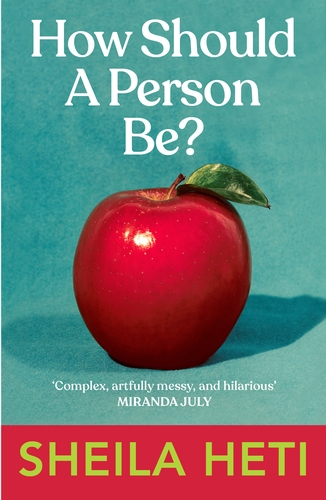What do you think?
Rate this book


306 pages, Paperback
First published September 25, 2010


How should a person be?Smart, funny, disgusting, insightful, this is a self-help book for people who don’t believe there are easy answers, or even any answers at all. When I first read the excerpts of this book, I thought where has this book been all my life? These are the questions I’ve been asking myself since forever!!! I’m surprised this exact book hasn’t been written before, so obvious are the questions asked that it seems oddly new. Perhaps because everyone asks themselves these questions and everyone also thinks ‘Nobody else asks these questions. Everybody else already knows the answers, everybody has their shit together and has figured this all out’. Or perhaps, like me, the questioner also lives with the fear that they are asking the wrong questions all along. What if all this time I’ve been missing the point entirely?
For years and years I asked it of everyone I met. I was always watching to see what they were going to do in any situation, so I could do it too. I was always listening to their answers, so if I liked them, I could make them my answers too. I noticed the way people dressed, the way they treated their lovers — in everyone, there was something to envy. You can admire anyone for being themselves. It’s hard not to, when everyone’s so good at it. But when you think of them all together like that, how can you choose? How can you say, I’d rather be responsible like Misha than irresponsible like Margaux. Responsibility looks so good on Misha, and irresponsibility looks so good on Margaux. How could I know which would look best on me?
In that moment, I wanted so much for someone to say of me: She is the most consistent person you have ever known. Even at home, she never changes! p.49This book is not available in the USA yet, but you can order it from Canada.
Writing, for me…in the first-person, is like a form of acting. So as I’m writing, the character or self I’m writing about and my whole self—when I began the book—become entwined. It’s soon hard to tell them apart. The voice I’m trying to explore directs my own perceptions and thoughts. But that voice or character comes out of a part of me that exists already. But writing about it emphasizes those parts, while certain other, balancing parts lie dormant—and the ones I’m exploring become bigger, like in caricature…who is “the first person” becomes confused.Thus, when fictional Sheila frankly and desirously details her sexual debasement with Israel, it can be (has been) easily transmuted into something the author herself is admitting to. And when she says that a woman “can’t find rest or take up home in the heart of another woman,” it can be seen as the author’s personal affront against feminism. But of course, Heti, like Chris Kraus in her epistolary novel I Love Dick, is here using sexual submission as a metaphor for the cultural powerlessness of women (where exposing the conditions of debasement is not the same thing as subscribing to it), and the importance of female friendship—and the novel’s intense, extended focus on the tensions and tenderness between Sheila and Margaux, their ability to, yes, rest and take up home in each other—form the heart of the narrative.
involves surprise, not just moving through your environment with this pre-determined idea of what you intend to do with it and how it should react to you. It’s like thinking you’ve been put on this earth to master life and make it submit.At the same time, in using transcriptions from real life to aid their fiction, both the creator and her protagonist have, in the latter’s words, cheated. How Should A Person Be? is, then, is a meditation on ugliness and baseness, and a contemplation of fiction only insofar as the stories we all tell ourselves about our own lives are considered. While it doesn’t quite provide any concrete answers, this is just as well. After all, neither the author nor her not-quite-stand-in are trying to be “just another man who’s trying to teach [you] something.”